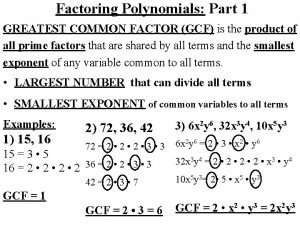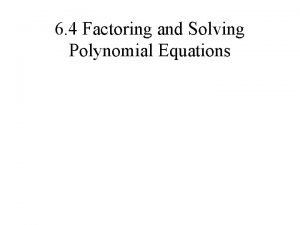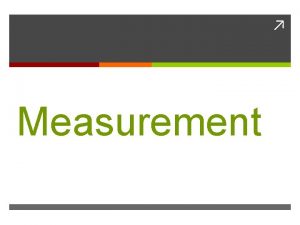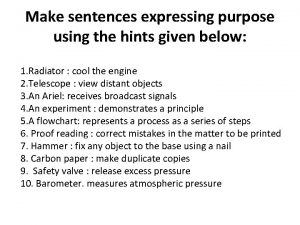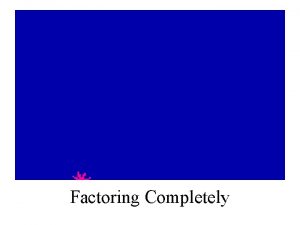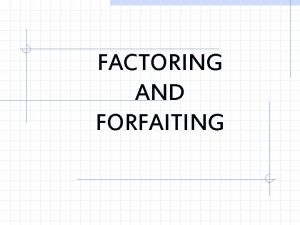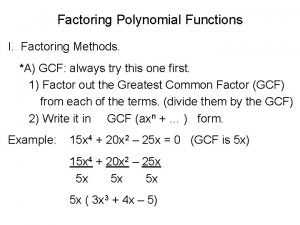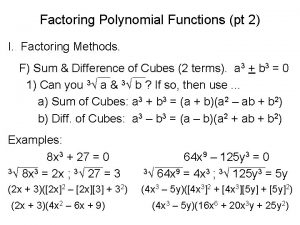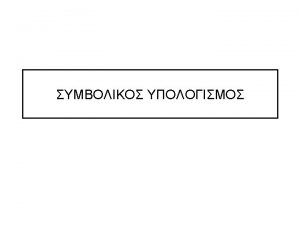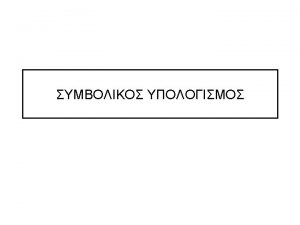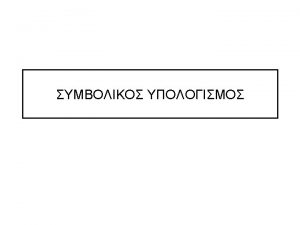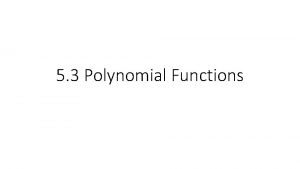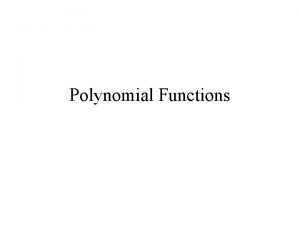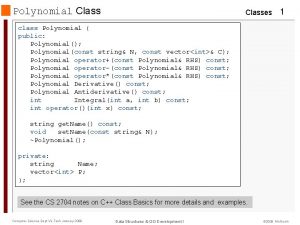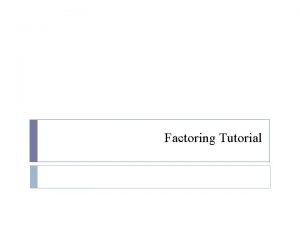Factoring a polynomial means expressing it as a






































- Slides: 38


Factoring a polynomial means expressing it as a product of other polynomials.

Factoring Method #1 Factoring polynomials with a common monomial factor (using GCF). **Always look for a GCF before using any other factoring method.

Steps: 1. Find the greatest common factor (GCF). 2. Divide the polynomial by the GCF. The quotient is the other factor. 3. Express the polynomial as the product of the quotient and the GCF.

Step 1: Step 2: Divide by GCF

The answer should look like this:

Factor these on your own looking for a GCF.

Factoring Method #2 Factoring polynomials that are a difference of squares.

A “Difference of Squares” is a binomial (*2 terms only*) and it factors like this:

To factor, express each term as a square of a monomial then apply the rule. . .

Here is another example:

Try these on your own:

End of Day 1

Sum and Difference of Cubes:

Write each monomial as a cube and apply either of the rules. Rewrite as cubes Apply the rule for sum of cubes:

Rewrite as cubes Apply the rule for difference of cubes:

Factoring Method #3 Factoring a trinomial in the form: where a = 1

Factoring a trinomial: 1. Write two sets of parenthesis, (x ). These will be the factors of the trinomial. 2. Find the factors of the c term that add to the b term. For instance, let c = d·e and d+e = b then the factors are Next

x x -2 Factors of +8: -4 1&8 1 + 8 = 9 2&4 2 + 4 = 6 -1 & -8 -1 - 8 = -9 -2 & -4 -2 - 4 = -6 Factors of +8 that add to -6

Check your answer by using FOIL F O I L

Lets do another example: Don’t Forget Method #1. Always check for GCF before you do anything else. Find a GCF Factor trinomial

When a>1, let’s do something different! Step 1: Multiply a · c = - 30 Step 2: Find the factors of a·c (-30) that add to the b term

Factors of 6 · (-5) : 1, -30 1+-30 = -29 -1, 30 -1+30 = 29 2, -15 2+-15 =-13 -2, 15 -2+15 =13 3, -10 3+ -10 =-7 -3, 10 -3+ 10 =7 5, -6 5+ -6 = -2 Step 2: Find the factors of a·c that add to the b term Let a·c = d and d = e·f then e+f = b d = -30 e = -2 f = 15

-2, 15 -2+15 =13 Step 3: Rewrite the expression separating the b term using the factors e and f Step 4: Group the first two and last two terms.

Step 4: Group the first Two and last two terms. Step 5: Factor GCF from each group Check!!!! If you cannot find two common factors, Then this method does not work. Step 6: Factor out GCF Common factors

I am not a fan of guess and check! Step 3: Place the factors inside the parenthesis until O + I = bx. Try: F O I O + I = 30 x - x = 29 x L This doesn’t work!!

Switch the order of the second terms and try again. F O I O + I = -6 x + 5 x = -x L This doesn’t work!!

Try another combination: Switch to 3 x and 2 x F O O+I = 15 x - 2 x = 13 x I L IT WORKS!!

Factoring Technique #3 continued Factoring a perfect square trinomial in the form:

Perfect Square Trinomials can be factored just like other trinomials (guess and check), but if you recognize the perfect squares pattern, follow the formula!

a Does the middle term fit the pattern, 2 ab? Yes, the factors are (a + b)2 : b

a Does the middle term fit the pattern, 2 ab? Yes, the factors are (a - b)2 : b

Factoring Technique #4 Factoring By Grouping for polynomials with 4 or more terms

Factoring By Grouping 1. Group the first set of terms and last set of terms with parentheses. 2. Factor out the GCF from each group so that both sets of parentheses contain the same factors. 3. Factor out the GCF again (the GCF is the factor from step 2).

Example 1: Step 1: Group Step 2: Factor out GCF from each group Step 3: Factor out GCF again

Example 2:

Try these on your own:

Answers:
 Factoring polynomials with gcf
Factoring polynomials with gcf 3-4 factoring polynomials
3-4 factoring polynomials Factoring polynomials
Factoring polynomials Solving polynomials
Solving polynomials Numpy.polynomial.polynomial
Numpy.polynomial.polynomial How to divide a polynomial by another polynomial
How to divide a polynomial by another polynomial Triangle quadrilateral pentagon hexagon octagon
Triangle quadrilateral pentagon hexagon octagon Life bio
Life bio Meta means and morphe means
Meta means and morphe means Meta means in metamorphism
Meta means in metamorphism Define biodiversity conservation
Define biodiversity conservation What is the most obvious channel of expressing emotions
What is the most obvious channel of expressing emotions Verb expressing emotion
Verb expressing emotion Ways of expressing future tense
Ways of expressing future tense It is a group of words that express a complete thought
It is a group of words that express a complete thought The art of expressing one's thoughts in verse
The art of expressing one's thoughts in verse Expressing trinomials
Expressing trinomials Make sentences expressing purpose using the given hints
Make sentences expressing purpose using the given hints Would sooner
Would sooner Lack of obligation examples
Lack of obligation examples Can could shall should
Can could shall should Expressing sympathy dialogues
Expressing sympathy dialogues Expressing yourself through music
Expressing yourself through music Chapter 3 achieving mental and emotional health answer key
Chapter 3 achieving mental and emotional health answer key Expressing permission
Expressing permission Expressing capability
Expressing capability Measuring and expressing enthalpy changes
Measuring and expressing enthalpy changes Chapter 10 re-expressing data
Chapter 10 re-expressing data What is the most obvious channel of expressing emotions
What is the most obvious channel of expressing emotions Different ways of expressing future
Different ways of expressing future Define scientific notation
Define scientific notation Connectives that express cause and effect
Connectives that express cause and effect Will i going to razlika
Will i going to razlika Expressing likes and dislikes dialogues
Expressing likes and dislikes dialogues Expressing interest
Expressing interest Tobacco plant with firefly gene
Tobacco plant with firefly gene Expressing quantities
Expressing quantities Expressing ideas meaning
Expressing ideas meaning Paragraph expressing your opinion
Paragraph expressing your opinion
